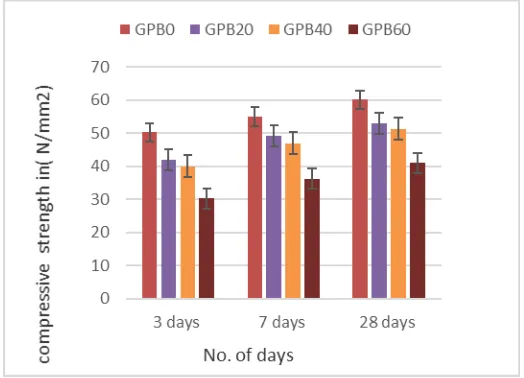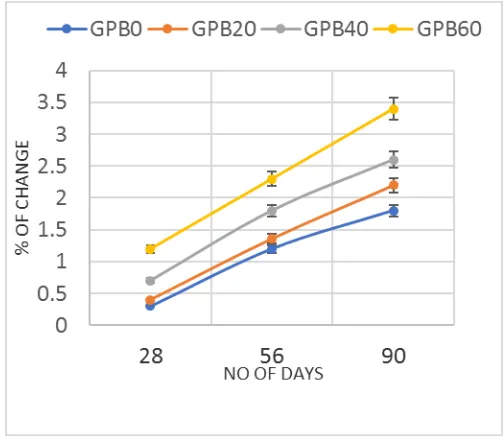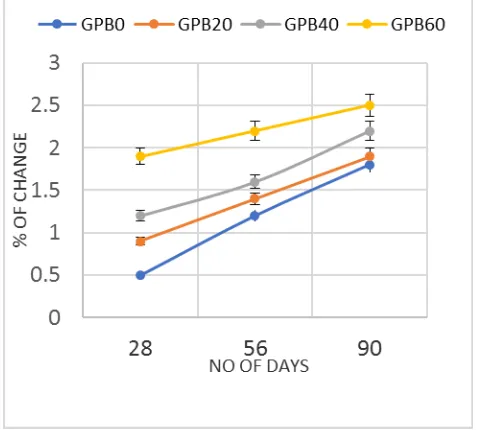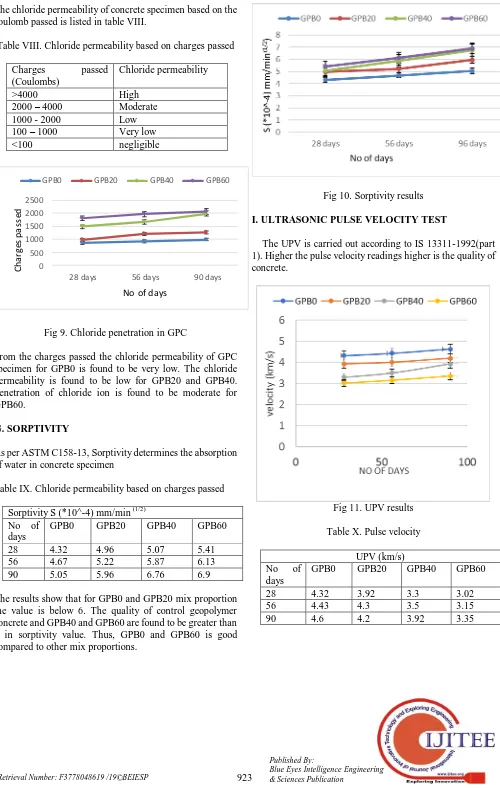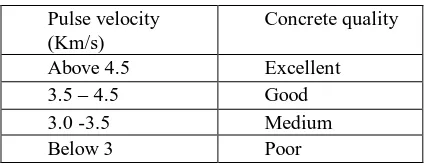International Journal of Innovative Technology and Exploring Engineering (IJITEE) ISSN: 2278-3075, Volume-8 Issue-6, April 2019
Abstract: The modern engineering has successfully involved in developing innovative, sustainable, green and recycled products in the manufacture of concrete. In India, the demand of natural sand is quite high due to the rapid infrastructural growth. The abundance availability of Fly ash and bottom ash that needed to be disposed of in a friendly way. Bottom ash has potential to be used as concrete material in place of fine aggregate. This paper elaborates the effect of bottom ash as fine aggregate in Geopolymer concrete. Bottom ash used as fine aggregate replaced partially in geopolymer concrete. GGBFS is used as Cement replacement in geopolymer concrete. NaOH and Na2SiO3 activator are used as binder in geopolymer
concrete. The test involved designation of 20%, 40 % & 60% of bottom ash (BA) as a partial replacement of fine aggregate to study the engineering properties (compression test, split tensile strength) and the functional properties (test on sulphate resistance, salt water resistance, test on acid resistance, RCPT, sorptivity also quality assessment test (UPV test) and the test results indicate that there is decrease in compressive stress with increase of bottom ash, it is observed that 20%to 40% replacement of bottom ash has good strength and durability
Index Terms: bottom ash, durability study, engineering properties, geopolymer concrete,
I.INTRODUCTION
Concrete is most widely used material in construction and the ordinary Portland cement (OPC) is the major ingredient used in Portland cement concrete. Cement producing industry emits CO2 gas which is dangerous greenhouse gas and also leads to environmental pollution. So, alternate binder should be used in concrete instead of cement but with chemical properties similar to cement. The industrial by-products such as fly ash, bottom ash, ggbfs has similar properties to cement. Bottom ash is the by-products of coal and they are disposed in large amount. There is a huge demand for sand (fine aggregate) in concrete, instead of disposing the bottom ash as land fill or waste material. Bottom ash can be used in fine aggregate as partial replacement. They are capable to be used in construction and road pavements.
GGBFS is used as an alternative of Portland cement binder in geopolymer concrete. The geopolymer concrete attains
Revised Manuscript Received on April 07. 2019. Magesh M, M.Tech (Structural Engineering)., VIT Chennai , India
Jawahar S, M.Tech (Structural engineering)., VIT Chennai , India
Dhanesh E, Manager–Technical Service, JSW Cements limited,Chennai,
Various materials are replaced in geopolymer concrete to improve the strength of geopolymer concrete in such way that glass fines are used as replacement for fine aggregate which shows low density and high strength [1]. The other materials such as Fly ash, Nano silica and steel fiber incorporated 12M geopolymer concrete produced high compressive strength [2]. Spent garnet also used as fine aggregate in self-compacting which shows good workability in geopolymer concrete [3] Light weight geopolymer concrete with fly ash as binder and bottom ash fine aggregate used as thermal insulator and modern strength [4].Fly ash was replaced in geopolymer binder and they showed density of 1500kg/m3 and compressive strength of 17.5 MPa [5].There are some re-cycled materials such as Electronic waste was used as fine aggregate at different proportion which shows moderate increase in the compressive strength [6]. Recycled coarse aggregate also used as fine aggregate in geopolymer concrete [7]. Bottom ash is used fine aggregate in fly ash and fly ash-bottom ash based geopolymer concrete in which bottom ash is significantly low.[8]. Granite slurry was also used in geopolymer concrete as fine aggregate in fly ash and GGBFS as binder [9]. Lime stone and oil palm shell OPS used as fine aggregate in geopolymer concrete [10] Bottom ash is partially replaced with fine aggregate at different proportion and 20% replacement is found to be optimum replacement [11]. Bottom ash used at partial and full replacement of fine aggregate in fly ash based geopolymer concrete [12].
In this investigation the bottom ash is used as fine aggregate in geopolymer concrete at replacement level of 0%,20%,40% and 60% to evaluate the engineering properties (compressive strength test, split tensile test) for 3,7 and 28 days and durability tests (salt water resistance, acid attack tests, sulphate attack test, RCPT, sorptivity) for 28,56 and 90 days and quality assessment test.
II. MATERIALS A.GGBFS
Ground granulated blast furnace slag was used as binder in this study. This geopolymer concrete consist of 100% ggbfs. The chief chemical components of ggbfs are similar to cement. The alkaline solution is used in this instead of water
Influence of Bottom Ash as Fine Aggregate in
Ggbfs Geopolymer Concrete
B. Alkaline solution
Sodium hydroxide and sodium silicate was used as alkaline solution in this geopolymer concrete. The NaOH/Na2SiO3 ratio is 2.5. NaOH is available in pellets form. It is dissolved in water a day prior to use to make required molarity / concentration .10M = (10 x 40 = 400gm). Na2SiO3 is available in brownish colored.
C. Bottom ash
Bottom ash was collected from nearby Thermal power plant. The chemical composition found to be more similar to sand. Thus, the bottom ash is partially replaced in sand at different mix proportion. The properties of bottom ash are listed in Table 1
Table I. Properties of bottom ash
Physical properties of bottom ash
S.no Property Value
1 Specific gravity 1.7
2 Water
absorption by mass (%)
30.2
3 Fineness
modulus
1.37
D. Superplasticizer
To achieve the workability for concrete, superplasticizers are used. In this, 5% of polycarboxylic ether is used as superplasticizer
E. Water
Generally, water is used to achieve workability for concrete. In this geopolymer concrete 12% water is used.
III. MIXPROPORTIONANDEXPERIMENTAL PLAN
All ingredients such as GGBS, fine aggregates and coarse aggregates were mixed in dry condition for 3-4 minutes then alkaline activator solution was added Sodium hydroxide pellets was mixed in water 24 hours before mixing with sodium silicate solution. Alkaline activator solution was prepared 3-4 hours before mixing. Bottom ash is partially replaced at 0,20,40,60% in sand their mix proportion is shown in table II.
Table II. Mix proportion
The mix proportion has been done based on the specific gravity of the bottom ash and sand. The mix proportion where given specimen ID. The properties of fresh concrete have been tested and then the specimen is tested for engineering and durability properties. The various percentage of replacement are done only for fine aggregate as follows
a) GPB0 – Control GPC, with M sand
b) GPB20- 20% replacement of M-sand with BA c) GPB40- 40% replacement of M-sand with BA. d) GPB60- 60% replacement of M-sand with BA.
Table III. Mix proportion with MIX-ID
Specime n ID
GGBFS (Kg/m3 )
Fine aggregate (Kg/m3)
Coarse aggregate (Kg/m3)
Sand Bottom
ash
GPB0 330 749 0 1344.
GPB20 330 608 97 1344
GPB40 330. 456 196 1344
GPB60 330 304 294 1344
IV. EXPERIMENTALRESULTSANDDISCUSSION A.COMPRESSIVE STRENGTH
[image:2.595.303.565.441.630.2]The specimen was tested as per IS: 516-59. Compressive strength of geopolymer concrete specimen was tested for 3,7 and 28 days. The results are shown in Fig 1.
Fig 1. Variation in compression strength
The geopolymer concrete attains high early strength because of geopolymerisation process the results show that there is no increase in compressive strength with increase of bottom ash percentage. The percentage of change in GPB20 compared to GPB0 is 12%. GPB20 AND GPB40 is almost in the same range and they are good in compressive
strength compared to GPB60.
Materials 0%
(Kg/m3 )
20% (Kg/m3 )
40% (Kg/m3 )
60% (Kg/m3 )
GGBFS 330.66 330.66 330.66 330.66
Fine aggregat e
sand 749.4 608.74 456.56 304.37
Bottom ash
0 97.98 196 294
International Journal of Innovative Technology and Exploring Engineering (IJITEE) ISSN: 2278-3075, Volume-8 Issue-6, April 2019
B. SPLIT TENSILE STRENGTH TEST
[image:3.595.302.554.62.280.2]The tensile test was conducted as per IS 5816. The split tensile test is conducted for 3,7 and 28 days and their results are shown in Fig 2.
Fig 2. Variation in tensile strength
The split tensile results show that the GPB0 remains to have high tensile strength compared to all other mix proportion. The 28 days result for GPB20 shows that their tensile value is similar to GPB0 and GPB40 shows good tensile value compared to GPB60.
C. SALT WATER RESISTANCE
The sample kept in 10% of sodium chloride (NaCl) solution and the pH value were maintained and checked for weight and compressive strength. The compressive strength and weight of chloride attack specimen is compared to initial strength and weight.
Fig 3. Variation of Compressive strength in salt water
The compressive strength of all mix proportion for salt water resistance at 28,56 and 90 days shown in Fig 3. The percentage of change for all mix proportion with their mix ID is shown in fig 4.
[image:3.595.58.279.131.320.2]
Fig 4. Percentage of change in strength against chloride
Table IV. % of change in strength against chloride
Mix proportion
% of change
28 days 56 days 90 days
GPB0 0.3 1.2 1.8
GPB20 0.4 1.36 2.2
GPB40 0.7 1.8 2.6
GPB60 1.2 2.3 3.4
The results show that the maximum percentage of change for GPB60 is 3.4% and GPB20 and GPB40 are similar and significantly less compared to the GPB0.
D. ACID ATTACK TEST
As per standards of ASTM C- 267 the acid tests was conducted. The sample kept in 10% of sulfuric acid solution and the pH value were maintained and checked for weight and compressive strength. The compressive strength and weight of acid attack specimen is compared to initial strength and weight of specimen. and the results, percentage of change in compressive strength is listed below.
Table V. % of change in strength against acid
Mix proportion
% of change
28 days 56 days 90 days
GPB0 2.18 3.07 5.4
GPB20 2.49 3.19 6.1
GPB40 2.87 4.02 6.7
GPB60 3.01 5.57 7.06
[image:3.595.300.556.352.429.2] [image:3.595.59.273.517.665.2]Fig 5. Variation of Compressive strength in acid attack
Fig 6. Percentage of change in strength in acid attack
E. SULPHATE ATTACK TEST
[image:4.595.57.274.62.200.2]As per ASTM C 1012-10 the test procedure is followed. Samples were immersed in 10% sulphate solution and the test is conducted and the percentage of change in compressive strength is shown in Table VI.
Table VI. % of change in strength in acid attack
Mix proportion
% of change
28 days 56 days 90 days
GPB0 0.5 1.2 1.8
GPB20 0.9 1.4 1.9
GPB40 1.2 1.6 2.2
GPB60 1.9 2.2 2.5
[image:4.595.303.542.233.448.2]Fig 7. Variation of Compressive strength in sulphate attack
Fig 8. Percentage of change in strength against sulphate
The percentage of change was found to be low compared to all other chemical attack and the maximum percentage of change in GPB60 is found to be 2.5%. this shows that the GPC concrete is resistant against sulphate.
F. RAPID CHLORIDE PENETRATION TEST
. The RCPT test procedure is followed as per ASTM C 1202. The potential of 60V is passed through the specimen of 50mm thick and 100 mm diameter for about 6 hours and the reading was noted for every 15min. One side of the specimen is filled with sodium chloride and the other side with sodium hydroxide. The total charge in coulombs passed is tabulated.
Table VII. Chloride penetration
RAPID CHLORIDE PENETRATION TEST (coulombs) No of
days
GPB0 GPB20 GPB40 GPB60
28 864 983.5 1485 1800
56 923 1200 1653 1963
90 989 1256 1980 2064
[image:4.595.45.281.240.469.2]International Journal of Innovative Technology and Exploring Engineering (IJITEE) ISSN: 2278-3075, Volume-8 Issue-6, April 2019
[image:5.595.53.553.47.835.2]The chloride permeability of concrete specimen based on the coulomb passed is listed in table VIII.
Table VIII. Chloride permeability based on charges passed
Charges passed
(Coulombs)
Chloride permeability
>4000 High
2000 – 4000 Moderate
1000 - 2000 Low
100 – 1000 Very low
<100 negligible
0 500 1000 1500 2000 2500
28 days 56 days 90 days
C
h
a
rg
es
p
a
ss
ed
No of days
GPB0 GPB20 GPB40 GPB60
Fig 9. Chloride penetration in GPC
From the charges passed the chloride permeability of GPC specimen for GPB0 is found to be very low. The chloride permeability is found to be low for GPB20 and GPB40. Penetration of chloride ion is found to be moderate for GPB60.
G. SORPTIVITY
As per ASTM C158-13, Sorptivity determines the absorption of water in concrete specimen
Table IX. Chloride permeability based on charges passed
Sorptivity S (*10^-4) mm/min (1/2) No of
days
GPB0 GPB20 GPB40 GPB60
28 4.32 4.96 5.07 5.41
56 4.67 5.22 5.87 6.13
90 5.05 5.96 6.76 6.9
The results show that for GPB0 and GPB20 mix proportion the value is below 6. The quality of control geopolymer concrete and GPB40 and GPB60 are found to be greater than 6 in sorptivity value. Thus, GPB0 and GPB60 is good compared to other mix proportions.
Fig 10. Sorptivity results
I. ULTRASONIC PULSE VELOCITY TEST
The UPV is carried out according to IS 13311-1992(part 1). Higher the pulse velocity readings higher is the quality of concrete.
Fig 11. UPV results
Table X. Pulse velocity
UPV (km/s)
No of
days
GPB0 GPB20 GPB40 GPB60
28 4.32 3.92 3.3 3.02
56 4.43 4.3 3.5 3.15
Table XI. Charges based concrete quality
GPB0 and GPB20 shows good quality of concrete based on the velocity passed and GPB40 and GPB60 shows medium quality of concrete. Thus, the GPB mix proportion lies in the average range of good to medium
V. CONCLUSION
Based on the results obtained from the experiments the subsequent conclusions can be derived regarding the performance of the concrete
1. It is observed that as the percentage of increase in bottom ash there is subsequent decrease in compressive and tensile strength of concrete. Mix GPB20 and GPB40 have high potential to meet the strength and workability properties.
2. Durability properties of concrete by various test show that the chemical resistance of GPB20 and GPB40 are almost similar and significantly less compared to GPB0. 3. Based on the NDT test it is observed that on various
percentage of concrete mix they produced good results 4. The optimum mix of GPB20 and GPB40 has been
evaluated based on the strength and durability
REFERENCES
1. Ailar Hajimohammadi , Tuan Ngo , Alireza Kashani (2018). Sustainable one-part geopolymer foams with glass fines versus sand as fine aggregate. Construction and Building Materials 171 223–231
2. Jumah Musdif Their, Mustafa ozakca (2018). Developing geopolymer concrete by using cold-bonded fly ash aggregate, nano-silica, and steel fiber. Construction and Building Materials 180 12–22.
3. Habeeb Lateef Muttashara, Mohd Azreen Mohd Ariffinb, Mohammed Noori Husseinc, Mohd Warid Hussinb ,Shafiq Bin Ishaqb( 2017). Self compacting geopolymer concrete with spend garnet as sand replacement. Journal of Building Engineering 15 85–94.
4. Ampol Wongsa, Yuwadee Zaetang, Vanchai Sata, Prinya Chindaprasirt a (2016). Properties of lightweight fly ash geopolymer concrete containing bottom ash as aggregate. Construction and Building Materials 111 637–643.
5. Patcharpol posi, Pearl poy (2016). Pressed light weight fly ash OPC geopolymer concrete
6. Containing recycled light weight concrete aggregate. Construction and Building Materials 127 (2016) 450–456
7. Mahaboob Basha , Bhupal Reddy Ch & Vasugi K.(2016) strength behaviour of geopolymer concrete replacing fine aggregate by M-sand and E-waste. International Journal of Engineering Trends and Technology (IJETT) – Volume-40 Number-7 - October 2016
8. Faiz Uddin Ahmed Shaikh (2016) Mechanical and duability properties of fly ash geopolymer concrete containing recycled coarse aggregate. International Journal of Sustainable Built Environment (2016)
9. Tianyu Xie, Togay Ozbakkaloglu (2015). Behavior of low-calcium fly and bottom ash-based geopolymer concrete cured at ambient temperature. Ceramics international 2015.01.031
10.Sreenivasulu1, A. Ramakrishnaiah and J. Guru Jawahar (2015). Mechanical properties of geopolymer concrete using granite slurry as sand replacement. International Journal of Advances in Engineering & Technology, Apr., 2015. Vol. 8, Issue 2, pp. 83-91
11. Andri Kusbiantoro1, Nasir Shafiq, Muhd Fadhil Nuruddin (2015). Strength and Microstructural Properties of Fly Ash based Geopolymer Concrete containing High-Calcium and Water-Absorptive Aggregate. Journal of Cleaner Production.06.058.
12. Yogesh Aggarwal a, Rafat Siddique (2013). Microstructure and properties of concrete using bottom ash and waste foundry sand as partial replacement of fine aggregates. Construction and Building Materials 47 1444–1450 13. Shaw Shen, fung (2010). Fly Ash-Based Geopolymer Mortar
Incorporating Bottom Ash. Modern applied science vol. 4,No.
14. T.R. Naik, Sustainability of concrete construction (2008), Pract. Period.Struct.Des.Constr.1398–103,http://dx.doi.org/10.1061/(ASCE)10 84-0680(2008) 13:2(98).
15. M.P. Monteiro, (2015) Concrete: Microstructure, Properties, and Materials, 2015. (Accessed November 25).
16. M. P. Kadam (2013),Effect of coal bottom ash as sand replacement on the properties of concrete with different w/c ratio, International Journal of Advanced Technology in Civil Engineering, ISSN: 2231–5721,Volume-2, Issue-1.
17. P. Tang, (2012) The application of MSWI bottom ash fines in high performance concrete, 1st International Conference on the Chemistry of Construction Materials.
18. Yogesh Aggarwal, Rafat Siddique (2014), Microstructure and properties of concrete u sing bottom ash and waste foundry sand as partial replacement of fine aggregates, Construction and Building Materials 54 210–223. 19. ]Kim H K, Lee H K (2011), Use of power plant bottom ash as fine and
coarse aggregate in high-strength concrete ,Constr Build Mater; 25:1115–22.
20. IS 516-1959., Indian Standard methods of tests for strength of concrete, Bureau of Indian Standards,2006.
AUTHORS PROFILE
Pulse velocity (Km/s)
Concrete quality
Above 4.5 Excellent
3.5 – 4.5 Good
3.0 -3.5 Medium
Below 3 Poor
Jawahar.S, Student of final year M.Tech, VIT Chennai,600124, India.
Jawaharsekar85@gmail.com
7200401463
Magesh.M, Student of final year M.Tech, VIT Chennai,600124, India.
mageshpeculiar@gmail.com 7845644006
Dhanesh E, Manager–Technical Service, JSW Cements limited,Chennai, India
dhanesh.elango@jsw.in> 96000 77886
Dr.Vasugi.V, Associate Professor , School of Mechanical and Building Science, VIT , Chennai, India.
